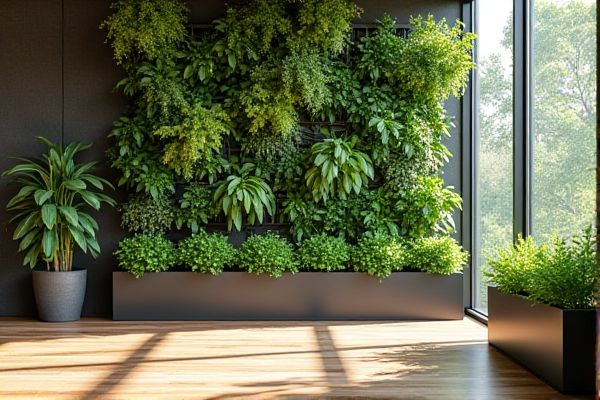
Vertical gardens maximize limited space by growing plants upward on walls or structures, while container gardens offer flexibility with plants in portable pots or containers suited for patios and balconies. Explore the rest of the article to discover which garden style best fits your space and gardening goals.
Table of Comparison
| Feature | Vertical Garden | Container Garden |
|---|---|---|
| Space Efficiency | High - uses vertical wall space | Moderate - uses horizontal surface |
| Plant Variety | Suitable for small, trailing, or climbing plants | Accommodates wide range including larger plants |
| Setup Complexity | Moderate to high - requires mounting and irrigation system | Low - simple pots with soil |
| Maintenance | Requires regular watering; drainage management important | Easy to manage; pots can be moved for sunlight |
| Ideal Location | Walls, fences, or indoor vertical spaces | Balconies, patios, indoor floors |
| Cost | Higher initial cost due to structure and irrigation | Lower initial cost; pots and soil only |
| Water Usage | Efficient with drip irrigation systems | Varies; can require frequent watering |
Introduction to Vertical and Container Gardens
Vertical gardens utilize vertical structures such as trellises, walls, or panels to maximize growing space, making them ideal for small or urban areas. Container gardens involve planting in pots, buckets, or other movable containers, offering flexibility in location and soil control. Both methods support diverse plant types but differ in space efficiency and design adaptability.
Space Efficiency: Vertical vs Container Solutions
Vertical gardens maximize space by utilizing walls or vertical structures, making them ideal for small areas or urban settings. Container gardens offer flexibility in plant placement but can consume more floor space, limiting their use in tight environments. Your choice depends on how efficiently you need to use available space and the type of plants you want to grow.
Plant Variety and Suitability
Vertical gardens maximize space by supporting climbing plants like beans, peas, and vines, making them ideal for small or urban areas. Container gardens provide greater plant variety, accommodating flowers, herbs, and vegetables by offering different soil conditions and mobility. Your choice depends on available space, plant types, and garden maintenance preferences.
Watering and Irrigation Requirements
Vertical gardens require efficient drip irrigation systems to ensure even water distribution to all plants, minimizing water waste and preventing runoff. Container gardens need more frequent watering since soil in pots dries out faster due to limited volume and exposure to air. To maintain your garden's health, adjusting irrigation schedules based on plant type and environmental conditions is essential for both vertical and container setups.
Installation and Maintenance Demands
Vertical gardens require structured support systems and careful selection of wall-friendly plants, demanding more precise installation compared to container gardens that offer flexibility and portability. Maintenance for vertical gardens involves regular irrigation, pruning, and monitoring for wall moisture issues, while container gardens allow easier access for watering and plant care, making them less labor-intensive. Choosing between the two depends on your available space and how much time you can dedicate to ongoing garden upkeep.
Aesthetics and Visual Impact
Vertical gardens create a striking visual impact by maximizing green space on walls, making them ideal for urban settings and small areas where floor space is limited. Container gardens offer flexibility in design and placement, allowing You to arrange plants in various shapes, sizes, and colors to complement your outdoor or indoor decor. Both garden types enhance aesthetics, but vertical gardens deliver a modern, living art feature, while container gardens provide a traditional, adaptable greenery display.
Cost Considerations and Budgeting
Vertical gardens often require a higher initial investment due to the cost of specialized structures, mounting hardware, and irrigation systems compared to container gardens, which can start with affordable pots and soil. You can manage your budget effectively by selecting container gardens for flexibility and incremental expansion, whereas vertical gardens demand upfront planning and spending. Maintenance costs may also vary, with vertical gardens needing more frequent water and fertilizer application, impacting long-term expenses.
Accessibility and Ergonomics
Vertical gardens enhance accessibility by allowing plants to be cultivated at eye level, reducing the need for bending or kneeling, which benefits individuals with limited mobility or back problems. Container gardens offer ergonomic flexibility through movable pots that can be positioned for optimal reach and comfort, making them suitable for diverse spaces and personal preferences. Your choice between vertical and container gardening should consider physical accessibility and ease of maintenance to ensure a sustainable and enjoyable gardening experience.
Urban Gardening: Which Method Wins?
Vertical gardens maximize space efficiency by utilizing walls and vertical surfaces, making them ideal for small urban balconies and limited spaces. Container gardens offer flexibility and ease of access, allowing gardeners to move plants based on sunlight and weather conditions. Both methods promote urban greenery, but vertical gardens outperform in space optimization, while container gardens excel in portability and plant variety.
Final Verdict: Choosing the Ideal Gardening Style
Vertical gardens maximize space efficiently by growing plants upward, ideal for small areas and urban settings, while container gardens offer more flexibility in plant variety and mobility, suitable for patios and balconies. The choice depends on available space, plant types, and maintenance preferences, with vertical gardens requiring less ground area and container gardens allowing better soil control. For optimal results, combine both methods to enhance greenery in limited spaces.
 homyna.com
homyna.com